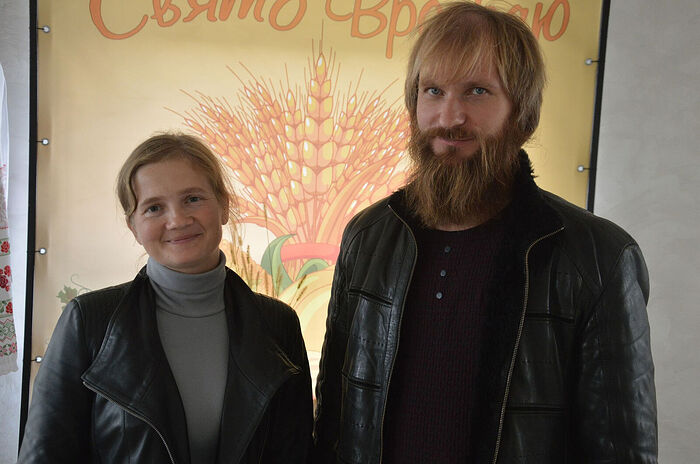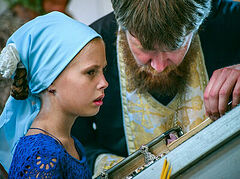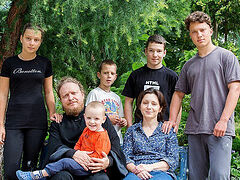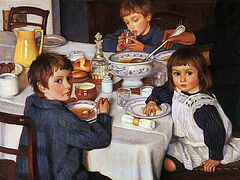The Cherkassy Orthodox School of St. Sergius of Radonezh in Ukraine is a unique educational institution. The educational process in it is based on the traditions of the Orthodox Church, along with the methods and recommendations of classical teachers and educators (such as K. Ushinsky, S. Rachinsky, G. Skovoroda and V. Sukhomlinsky). Special attention is given to labor and the physical education of children—each class has its own small plot of land on which children grow fruits and vegetables themselve; girls learn to sew, and boys do Greco-Roman wrestling. Once a week all of them ride horses, undergoing a course of riding therapy. The school has a farm, thanks to which the diet of its students consists of exclusively healthy eco-friendly food.
Priest Andrei Degterenko, the school’s principal, his wife Katerina, and some students talk about the foundation of the school, the organization of the educational process, and their everyday life.
“Be sure to visit it,” Metropolitan Theodosy (Snigiryov) of Cherkassy and Kanev encouraged us. “Our Orthodox school is truly unique. Its curriculum and teaching methods differ in many respects from those of modern schools.”
A conversation during the journey
And we set off. The school principal, Priest Andrei Degterenko, who kindly agreed to be our guide, took us to this educational institution, located twelve miles from Cherkassy, at the edge of a pine forest and a village... On the way, Fr. Andrei talked about how the school was set up.
 Priest Andrei and Katerina Degterenko, initiators of the project and heads of the Orthodox school
Priest Andrei and Katerina Degterenko, initiators of the project and heads of the Orthodox school
“Four years ago my wife Katerina, our son Matthew and I moved from Kiev first to Cherkassy, and then to a local village. When Matthew went to the first grade while still in the city, we noted that the modern curriculum of secondary schools is completely different what we used to have in our time. Moreover, we could not agree with many of the nuances of education. For example, already in elementary school, children are given so-called “sex education” lessons. We didn’t like textbooks full of bright flashy illustrations and comic strips that, in our opinion, interfere with the content of texts, and some contain an aggressive ideology. The excesses in the curriculum of modern schools with the imposition of ideas and values alien to our society couldn’t leave us indifferent. As communication with our colleagues shows, the same point of view is shared by many teachers of our schools and universities. But they are forced to follow this direction and can do nothing with it.
Then the idea of opening an Orthodox school came into being, for which we received the blessing of the reposed Metropolitan Sophrony (Dmitruk; †2020) of Cherkassy. But our idea didn’t begin to be implemented until the arrival of Metropolitan Theodosy in Cherkassy. Vladyka gives much of energy and time to the school, taking care of us like a father. For him, as for us, bringing up Orthodox children, unspoiled by modern confusions, is the main priority.
—What is special about the educational courses of your school?
—The school provides training, education and development of sixty students from the first to the eighth grades, including a preparatory year, based on the traditions of the Orthodox Church and taking into account the need for scientific and technical knowledge in children. We worked hard on examining and compiling the curricula. We also took into account the requirements of the Ministry of Education and Science in Ukraine. Training in the school is carried out through the children’s live communication with teachers in their native language with the additional integration of foreign (English, German) and Church Slavonic languages.
We devote much attention to the spiritual development of children in the “Orthodox Culture” and “Lives of the Saints” lessons, in which we try to convey basic Christian dogmas to our students, using examples from the biographies of saints and Church figures from different times.
—We heard that your students work in gardens and ride horses.
—That’s right. It is impossible to educate a child by only theoretical and practical classroom work. Modern curricula pay very little attention to the physical education of children. When I was at school, for example, we had practical work in the school garden during botany lessons. And even earlier, every school had greenhouses in which girls learned the basics of growing flowers. I will show you our farm. Each class has its own tiny plot of land, and children grow many vegetables on them—potatoes, beets, carrots, cabbages, marrows and pumpkins. Today we will have a harvest festival and choose the winners from among those who attended the Young Agronomist club.
You will see our goats, cows, horses and piglets. Only our own eco-friendly food is used to provide nutrition in the school. Cottage cheese, goats’ milk and various cheeses are included in our students’ diet. They optionally attend the Greco-Roman wrestling group and ride horses once a week—everyone undergoes a course of riding therapy.
 Horse Sonya is the school students’ favorite
Horse Sonya is the school students’ favorite
—Please tell us more about this.
—At one time I read in special textbooks that horse-riding therapy has a biomechanical effect on the human body, strengthening it. For example, it transmits motor impulses to a rider similar to the movements of a person when he walks. Since a horse’s temperature is 1.5 degrees higher than that of a human being, movements of the horse’s back muscles, consisting of many elements, have a massaging and gently warming effect on the muscles of a child’s legs and pelvic organs, which increases blood flow in the limbs. At a walk—the main gait used in riding therapy—a horse makes about 110 multidirectional oscillatory movements, which are transmitted to the rider.
In order to maintain the correct posture while riding, a rider must maintain balance, and coordinate and synchronize his movements. Thus, even in a patient with cerebral palsy, muscles begin to work that are inactive in everyday life. In addition, horse riding stimulates the development of fine motor skills and perseverance, and facilitates a harmonious perception of the world around. Riding therapy is recommended even for the treatment of mental disorders. It is no coincidence that once nobles and common folk alike used to ride horses from childhood. Military horsemen as a rule never got sick and lived long lives. For instance, the commander Semyon Mikhailovich Budyonny lived to age ninety.
The modeling, “Young Housewife”, guitar and other groups are also well attended. You will see it for yourselves.
So we came and saw
An Eastern European shepherd dog [a Ukrainian and Russian breed of shepherd dog.—Trans.] was the first to meet us, wagging its tail. Fr. Andrei’s friend guards a large farm—in the evening it walks around it with the master, and at night it guards the area and protects the goats, horses and cows from uninvited guests. Nearby are forest and a pasture, with a village a little further away.
We began our acquaintance with the farm from the shed in which goats and piglets live. There is a building next to the goat farm where goats’ hard cheese is made—not inferior in quality to the famous Dutch or French cheeses—along with goats’ cottage cheese and sour cream. A small mill was also installed here. They use their own flour to bake loaves of bread and buns, and pastries and cakes on holidays.
Fr. Andrei explained that goats’ cheese is easier to digest because the molecules of goats’ milk are small. In addition, it is rich in protein, phosphorus, retinol, and vitamin B2. And as for protein, calcium, zinc and other vitamins, goats’ cheese is not inferior to cows’ cheese. When entering the gastrointestinal tract, lactic acid bacteria prevent the development of pathogenic microorganisms. Therefore, goats’ cheese is considered to be very healthy for both adults and children.
Next we visited the cowshed. Milk from these cows is also very healthy, fatty and ideal for making curds, cheese, and sour cream.
We also visited a sewing workshop where girls learn to sew. School uniforms are made here as well.
 Here uniforms for students are sewn and girls are taught how to sew
Here uniforms for students are sewn and girls are taught how to sew
There is the Chapel of the Venerable Martyr Macarius on the hillock, in which prayer services are held. When the Liturgy is celebrated, it serves as an altar, and the school students and teachers pray in the courtyard beneath a tent, near the chapel.
A church is under construction a little further down. The lower part (where next year it will be possible to celebrate the Liturgy) is already finished. All the school students are as a rule from religious families. They go to confession and take Communion regularly.
“People often ask me where we get funds for the maintenance of the farm, the purchase of agricultural equipment, and the construction of quarters and the school’s main educational building,” Fr. Andrei said, forestalling my question. “The Lord helps us through people and sponsors. I have noticed that once a financial problem arises, I wonder if my wife and I are on the right track, and if it is necessary to build this or that object and purchase equipment. As a rule, the Lord points to the primary tasks. For example, buses were needed to take children from Cherkassy to classes and back. The Lord helped, and funds were soon found.
“The diocese supports us a great deal. Vladyka Theodosy often visits us, blesses practically all our undertakings, goes deeply into everything we do, and helps us financially. The metropolitan gives much attention to educational work. Meetings and conferences of Orthodox teachers of the Cherkassy region are held here. Vladyka says that unfortunately we have neglected a whole generation. This accounts for many, if not all, of our modern problems. And if right now we don’t do everything in our power to make up for lost time with repentance, the Lord will make us answer for this scrupulously. We fully agree with our archpastor.”
In the school
 Second graders. Anya Pakushina is first on the right
Second graders. Anya Pakushina is first on the right
The new school building is clean and spacious. At the entrance you’ll find a special box with compartments for each class. This is where the students put their cellphones. With the permission of the teacher Larisa Petrovna we were able to talk to the second graders and ask them a few questions. School students with ink pens (according to teachers, this cultivates beautiful handwriting) under the dictation of a teacher were writing letters diligently.
The children said that they loved their school and everything in it, especially horseback riding.
We visited almost all the classes, from the first to the eighth.
During our stay, Matushka Katerina came to the school. She spoke about how they had compiled the curricula and had obtained textbooks from the last century (the 1940s and the 1950s; some items are from the nineteenth century). Children pray before every lesson, and in each classroom icon lamps burn before the icons. Of course, there are occasional violations of discipline. In that case a student writes an explanatory note and explains what had prompted him to misbehave. If this happens frequently, the student may be expelled from the school.
 Metropolitan Theodosy of Cherkassy and Kanev with schoolchildren
Metropolitan Theodosy of Cherkassy and Kanev with schoolchildren
The high school students said that they saw a huge difference between the secular schools and this Orthodox school—here no one uses foul language or plays games on smartphones, and boys never smoke. And in this school, they feel the presence of the grace of God: “Like in a church,” one of them clarified.
In the refectory we were treated to a wonderful lunch made from farm products and fruits and vegetables grown by the students themselves.
There was a harvest festival that day.
On parting we photographed Fr. Andrei and Katerina, who presented us with goats’ cottage cheese and a loaf hard of goat cheese. They were both truly delicious.







